My love of cake straddles the line between innocent obsession and utter perversion. I tend to think of cakes like my favorite celebrity bodies. Be it big and firm like Hugh Jackman, petite and voluptuous like Salma Hayek, or thick and stacked à la Serena Williams, I have never laid eyes on a cake I didn’t fancy the same way. In my most delicious and twisted fantasy, I die face-down in red velvet with pound cake in my left hand and German chocolate in my right—an orgy so sweet that it literally takes me all the way to heaven. You see, I am absolutely crazy about cake, and so the (self-indulgent) focus of this Gastro-Vision post: three artists who take vastly different approaches to my most loved confection and, like me, somehow connect cake to people and personalities.
Dustin Wayne Harris
In Dustin Wayne Harris’s solo exhibition Cake Mixx, now on view at Heist Gallery in New York, viewers are invited to consider cake as more than dessert, but as a “valuable tool in the arsenal of psychoanalysis.” For the past year, following a first date, Harris has asked women to bake him a cake. He then reads it like a crystal ball. Harris says, “The way the cake looks never fails to become a metaphor for the relationship.” The artist’s collection of nine moderately-sized C-prints are each named for their baker.
“Take Chloe for example,” writes the artist, “you can see from her first cake, [that] the relationship had great promise. The second cake tells you that it ended badly.” With this bit of coaching from Harris, I found myself digging analytically deeper into his photographs, and in sudden awe of my new found faculty for cake reading. “That relationship turned into a mess,” I thought to myself in view of Erika, a blue cake that looked to be having a meltdown. Another cake titled Stephanie, a tall white-frosted mold with multi-colored confetti sprinkles and a shimmering cherry on top, led me to imagine a relationship that was nearly perfect, or at least that’s how it appeared on the surface.
Harris’s cake photos are not the stuff of Martha Stewart or Better Homes & Gardens. Unlike professional food photography, where styling agents like Vaseline and toothpicks are often used to create mouthwatering images, Harris’s works sometimes resemble the instantaneous snapshots of Flickr foodies. Some photographs are far more appealing than others, a technique that I gather is intentional. Meera, a gooey chocolate layer cake, crumbling at the edges where white cream seeps from the cracks, appears to have been tossed around in the back seat of a car. Harris captures this brown muddle atop a moss green cloth and a grimy wall that is equally as drab. While the cake is symbolic of the relationship in general, the care that Harris has taken to arrange it might speak to his own outlook. In Lindsey, for example, Harris has pulled back the pink wrapping to reveal a lovely, though oddly iridescent, frosted square. But in Lindsey 2, her pink heart-shaped cake is still covered and obscured by plastic wrap, perhaps a metaphor for Harris’s unwillingness to go further. On the other hand, Harris revealed in a recent interview that psychoanalysis is the primary and maybe only purpose of these cakes. One stayed in his fridge for a whole year. “All that sugar and preservatives,” Harris said, “…You shouldn’t eat cake.”
Victoria Howe
Culinary artist and pastry chef Victoria Howe launched Chinatown Cake Club (CCC) last December as a private fan club and secret New York City dessert spot. CCC offers a new menu every month featuring cakes of all kinds, with one cake made especially to honor an artist. Howe invites her guests to eat and socialize, watch screened movies, read the paper, or “simply sit in the corner and eat cake until you puke.” Sounds like my kind of party.
CCC is meant for serious cake lovers at heart. The top secret location is only open one evening per month, and a reservation – if you can get one – requires a multi-step process of email, snail mail, and text messaging. After months of trying, I finally got my foot in the door and cake in my belly last month. In Howe’s tiny apartment, I found a plethora of cake and the menu inspired by Americana. Black & White Icebox Cake, Texas Sheet Cake, Elvis Cake, Twinkies, Kentucky Bourbon Cake, Apple Brown Betty, and Budweiser Ice Cream were just some of the truly amazing options. A classic yellow cake filled with confetti sprinkles and covered with fluffy vanilla frosting was a special treat, a tribute to the American artist Henry Darger.
In previous months, cakes have been made in homage to photographer Nobuyoshi Araki, Art21’s Cindy Sherman, and late multimedia artist David Wojnarowicz. Howe explains what led her to start her Artist Tribute Series:
“I had done a job a few months before for the tourism board of Macau [China], making a huge cake that had photo transfers of cultural landmarks celebrating their heritage. I had never used edible transfers before, and was used to seeing them on really cheesy, ugly cakes – stuff that was completely unappealing and inedible to me. After I learned how to use transfers, I started thinking about ways to make a somewhat subversive cake, using images that would usually not have a place with baked goods, images that would be a tribute to artists I admired and respected.”
Some images work better than others for the photo transfer, which is created using edible rice paper with food-grade ink coloring. Darger’s painting, a long scroll of little girls and wavy flags amid a battle field, unfortunately could not be realized, but the cake was delicious nonetheless. The cake flavor, too, is meant to reference the artist. Howe said, “For the Araki cake, I wanted something garish and artificial-looking. Red Velvet was a perfect choice. It’s decadent and uses a ton of food coloring. It’s a cake of excess. For the Darger cake…I wanted to make a classic American cake, something kind of childish and not very sophisticated, kind of like a cake you’d make for a 7-year old girl’s birthday party in Ohio.”
Clare Grill
I have found that there’s only one thing better than birthday cake: Clare Grill’s paintings of them.
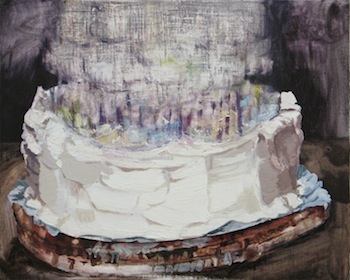
Clare Grill, "When You Get That Old," 2009. Oil on linen over panel, 20 x 16 in. Courtesy the artist.
Grill’s treatment of oil paint evokes the thick wisps and peaks of cake frosting—you can almost taste it. A combination of smooth brush strokes and gestural finger marks create an energy about her cakes that brings them to life. For a split second, it seems a dab of the finger on the surface of When You Get That Old (2009), currently on view at Edward Thorp Gallery in New York, might in fact result in something sweet. The smoke that appears to hover over the cake represents the moment just after the candles have been extinguished. Grill says, “I was thinking about what you could possibly wish for when you’re 100, so the piece is about the smoke of all those candles.”
Cakes are but a small part of Grill’s painting repertoire, in which she considers the fleeting moments of our lives and the “representational structures” we use to grab hold of them. To date, she has painted three different birthday cakes, each based on a photograph from her childhood. Cake (2009), topped with six glowing candles, is a replica of the cake from Grill’s sixth birthday. Beneath the surface of these works lies a story that is both personal and relevant to anyone who has ever made a wish. For Grill, birthday cake is a point of entry into the subject of belief (religious, magical, or historical, etc). She says, “I like the idea that if you pray really hard for something or wish on a coin or make a wish on your birthday candles, it will come true…these pieces are about stories, stories of believers and whether they’re right or wrong in their beliefs, and if it even matters.”
Cake Mixx is on view at Heist Gallery through April 18. A closing reception and poetry reading will be held on Saturday, April 17, 6-8pm. To learn more about Chinatown Cake Club, sign up for the mailing list. Grill’s work is on view at Edward Thorp Gallery through May 8; and in the project space at Sloan Fine Art, April 21-May 15. Prints of her cake painting Getting Older are available for purchase from 20 x 200.com.

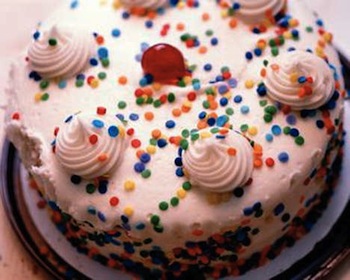
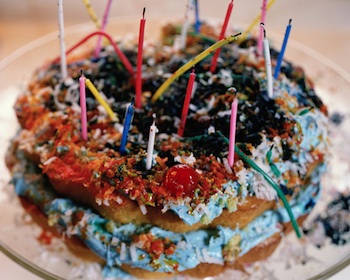
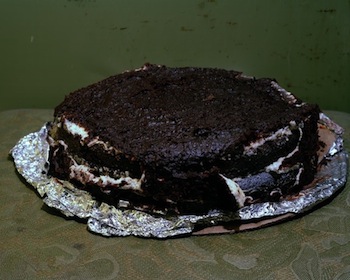
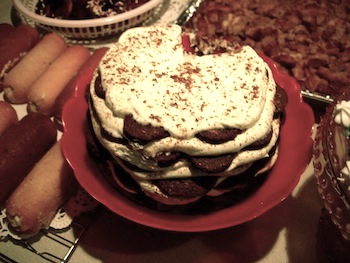
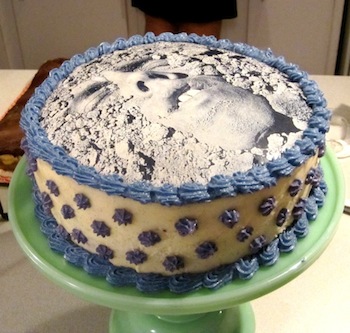
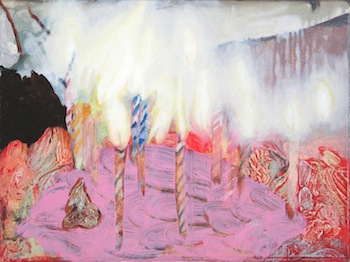



Pingback: Gastro-Vision | It Was a Sweet Year | Art21 Blog
Pingback: Let them eat cake. « The Longue Durée …
Pingback: Let them eat (bruise) cake. « The Longue Durée …